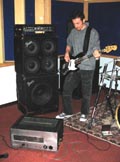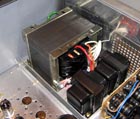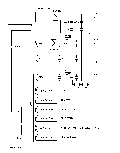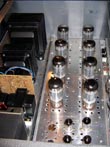 |
|
MOJAVE - guitar amp - 300W |
 |
A 300W amplifier for bass guitar has one not common requirement: the lowest frequency for a bass guitar, a five strings, is 25 Hz, and almost full power must be available at this frequency, with good control (i.e. damping factor).
I built this amplifier for a friend who plays bass guitar and loves hard rock.
My target was to build a guitar amplifier good both for bass and lead guitar, with high power and punch, which could work for hours at full power, near clipping and over.
To get the result we (the guitarist and I) agreed to avoid savings on weight, dimension and (sob!) money.
Obviously the core of such amplifier is the OPT, and the second factor is the power supply, while the circuit is all but exoteric.
At the end of the day we have a “toy” 60 cm wide, 43 cm deep, 28 cm high and…. 40Kg!
27 Kg of transformers.
|
Power Amplifier
|
|
 |
I started from the OPT, and after a lot of surfing and calculation the choice was the wonderful Sowter U072, rated for 400 W at 40 Hz, with 5 couples of 6550.
Its specs fit perfectly, with the proper working point, with 4 couples of 6550 for 300W, and 4 couples mean no overload to the power tubes.
|
 |
I chosed the Neutrik Speakon to connect the speaker, I do not believe that a jack is enough for 300 W.
The schematic is simple, with a long tail splitter in a very classic configuration, but a 12BH7 in cathode follower because 6550 is a hard tube to drive, and the 12AX7 has no capability to drive four 6550’s (in my opinion neither one 6550).The cathode follower is responsible of the punch of the amplifier.
|
 |
Only two gain stages, the phase splitter and the power tubes.This grants for a good phase behaviour, and only one pole for compensation allow an easy management of negative feedback without stability problems on any kind of load; the compensation capacitor on the plates of the splitter instead of on the feedback resistor avoids capturing radio frequency from the speaker cable.
|
Control Amplifier
|
|
 |
Again, no fantasy in this stage.
A low level input, a high level input, high and low frequency boost, a gain control, two gain stages, the tone control and the master volume.
The total gain is very high, and you can tweak the distortion choosing the input and balancing the gain control and the master volume.
|
 |
The total gain is very high, and you can tweak the distortion choosing the input and balancing the gain control and the master volume.
|
 |
The balanced output is built with the catodina splitter, which is the most balanced splitter if decoupled from the load, which is done by the 12BH7 in cathode follower.
|
Power Supply
|
|
 |
No savings in PWS, to get all the power at all frequencies, down to 25 Hz, and double main transformer to have a very effective stand by control: one transformer for all the filaments and for the control stage, and one only for the power stage (the beefier one, of course).
|
 |
There is a dedicated winding for the screen grids because 8 * 6550’s eat plenty of current at screen grids at a low (compared with plates) voltage.
|
Adjustment
|
|
 |
I set up the bias at 18 mA per tube, but this is of course a matter of taste: NFB is low and the sound is hard; up to you a softer sound with higher NFB and bias (do not exceed 50 mA if you do not want to burn the tubes).
|
|
Of course the higher the bias, the shorter the life of the tubes.
|
|
|
|